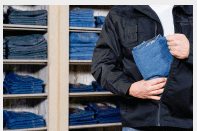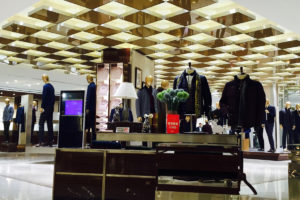 Big corporations across the globe worry about cybersecurity attacks and the repercussions those attacks have on the corporation’s bottom line. These cybersecurity attacks to their servers and information databases can be costly and can bring with them costly lawsuits as well. But, according to many analysts, employee theft and shoplifting are the more concerning issues affecting the retail industry. They alone account for more than two-thirds of their shrinkage and that figure seems to be rising every year. During the holiday season, those issues become more problematic and costly, and the retail industry looks for ways to prevent the great loses they will certainly suffer during this jolly time.
Big corporations across the globe worry about cybersecurity attacks and the repercussions those attacks have on the corporation’s bottom line. These cybersecurity attacks to their servers and information databases can be costly and can bring with them costly lawsuits as well. But, according to many analysts, employee theft and shoplifting are the more concerning issues affecting the retail industry. They alone account for more than two-thirds of their shrinkage and that figure seems to be rising every year. During the holiday season, those issues become more problematic and costly, and the retail industry looks for ways to prevent the great loses they will certainly suffer during this jolly time.
For more about this and other stories, follow the links below.
This crime in the workplace is costing US businesses $50 billion a year
There is a hidden risk facing small businesses across the country that often goes unnoticed until it suddenly rips through a firm’s finances: employee theft. It’s a crime that is costing U.S. businesses $50 billion annually, according to Statistic Brain.
Matt Ham can attest to that. He has had two run-ins with thefts by employees at his small business, Computer Repair Doctor, which has eight stores in Florida, Ohio and South Carolina, which collectively totals 30 employees.
At a store in Florida, two employees were caught stealing parts from inventory and skimming cash about a year and half ago, he said. After a thorough investigation, Ham sat them down with his attorney and they came up with a plan for restitution. Both employees had to pay back the thousands of dollars they stole. The chain has now put more safeguards in place, such as better inventory controls and a strict cash-counting process.
Survey finds no let up in one of retailers’ biggest threats
Nearly all retailers fell victim to organized retail crime during the past year. And the losses are mounting.
The survey of retail loss prevention employees found that losses averaged $726,351 per $1 billion in sales, up from $700,259 last year. Los Angeles continued to be the hardest-hit area for ORC in the nation, a position it has held since 2012. Following in order were New York City, Houston, Miami, Atlanta, Chicago, Orlando, San Francisco/Oakland, Orange County, Calif., and Northern New Jersey.
“Organized retail crime continues to be one of the biggest challenges to retailers of all sizes,” NRF VP for loss prevention Bob Moraca said. “These crimes happen across the country every day, with criminals getting smarter, more brazen, more aggressive and sometimes even attacking store employees and shoppers. Fighting ORC is a full-time job, and retailers must learn how to stay a step ahead of these thieves.”
Loss Prevention Trends to Watch During the Holiday Shopping Season
All retail eyes are focused on online security and digital transactions during the holiday season. But according to the National Retail Federation (NRF), shoplifting and employee theft accounted for more than two-thirds of inventory shrinkage in 2016. Retailers need to improve their internal security systems to boost their loss prevention abilities and keep their shrink rate from rising above last year’s historical high of 1.44 percent.
Retail store shrinkage is a known part of the industry, but with all the attention centered around cybertheft of customer information and implementing proper security measures at point-of-sale (POS) systems, the age-old problem of losing products at the physical store has taken a back seat.
Leveraging Cybersecurity Technology for Loss Prevention
Technology is playing a larger role across all retail efforts, and some of the tactics employed in the back office to protect the company’s digital data can be expanded to store-level prevention. The specifics of the skills needed differ between cybersleuths and on-the-floor store personnel, but more education and discussion between these disciplines can help.
 Could it be that Santa Claus is not always a jolly, giving man? Oh yeah. Take a
Could it be that Santa Claus is not always a jolly, giving man? Oh yeah. Take a 
 As a manager of a retail shop, the layout of the store is probably out of your hands and there is nothing to do about it.
As a manager of a retail shop, the layout of the store is probably out of your hands and there is nothing to do about it. As the biggest shopping season of the year seems inevitable close, retailers across the world prepare themselves to not only have a great holiday season but a profitable one.
As the biggest shopping season of the year seems inevitable close, retailers across the world prepare themselves to not only have a great holiday season but a profitable one. I wonder if Santa Clause conducts background checks on his newly hired elves? I’ve been contemplating the chaos that would take place in Santa’s workshop if he just hired any old elf to work for him. Does Santa ever get into a time crunch right around June and bring in seasonal hires to help meet timelines to get all of the toys made? Imagine the pilferage that would ensue if Santa’s Helpers haven’t been properly screened for criminal activity before being brought on board. Defective dolls might be delivered to darling little girls who deserve better. No firetrucks for a little fella because a fiendish elf stole it.
I wonder if Santa Clause conducts background checks on his newly hired elves? I’ve been contemplating the chaos that would take place in Santa’s workshop if he just hired any old elf to work for him. Does Santa ever get into a time crunch right around June and bring in seasonal hires to help meet timelines to get all of the toys made? Imagine the pilferage that would ensue if Santa’s Helpers haven’t been properly screened for criminal activity before being brought on board. Defective dolls might be delivered to darling little girls who deserve better. No firetrucks for a little fella because a fiendish elf stole it. According to the Small Business Administration (SBA), there are more than 28 million small businesses in the United States and they account for more than 99% of businesses in the country. Small businesses employ close to 57 million people in the United States alone and are a driving force in the progress of the US economy. The good news for an entrepreneur that wants to start a business is that they are not alone, but if you are a small business in the retail industry, the problems you will encounter do not come as paperwork filings or taxes paid. Shoplifting and employee theft are two of the major causes small retail shops face financial distress during their business enterprise. It is an unfortunate problem, but the problem is there and the small business owner has to find solutions to the specific problems in their store.
According to the Small Business Administration (SBA), there are more than 28 million small businesses in the United States and they account for more than 99% of businesses in the country. Small businesses employ close to 57 million people in the United States alone and are a driving force in the progress of the US economy. The good news for an entrepreneur that wants to start a business is that they are not alone, but if you are a small business in the retail industry, the problems you will encounter do not come as paperwork filings or taxes paid. Shoplifting and employee theft are two of the major causes small retail shops face financial distress during their business enterprise. It is an unfortunate problem, but the problem is there and the small business owner has to find solutions to the specific problems in their store.
 We’ve all been there, we are on our way to work and the next thing you know you come to a standstill. Cars backed up as far as you can see and no one is going anywhere. The clock is ticking away and you begin to worry knowing you are going to be late getting to the office. You look for a side street to try to get out of the mess then, someone with a little bit of guts and a four-wheel drive truck pulls onto the shoulder of the road and speeds by everyone to get to their destination. Everyone gets to where they are going but some people are determined not to let obstacles get in their way and they take the fast track to get there. They went the same route they just overcame the obstacles that would get in their way.
We’ve all been there, we are on our way to work and the next thing you know you come to a standstill. Cars backed up as far as you can see and no one is going anywhere. The clock is ticking away and you begin to worry knowing you are going to be late getting to the office. You look for a side street to try to get out of the mess then, someone with a little bit of guts and a four-wheel drive truck pulls onto the shoulder of the road and speeds by everyone to get to their destination. Everyone gets to where they are going but some people are determined not to let obstacles get in their way and they take the fast track to get there. They went the same route they just overcame the obstacles that would get in their way.
